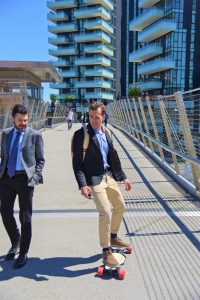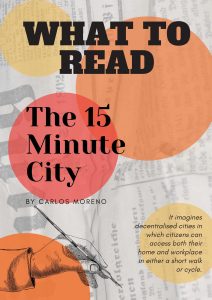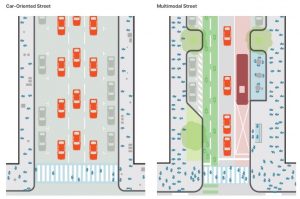Reducing CO2 and pollutant emissions from urban mobility is one of the EU’s ambitious goals for creating more sustainable European cities. Currently, over 70% of EU citizens live in urban areas, and over 80% of the EU’s GDP is generated in cities. However, urban congestion jeopardizes EU goals for a competitive and resource-efficient transport system. Urban transport is responsible for about a quarter of CO2 emissions from transport. Consequently, clean and smart urban mobility has become an important factor for cities to flourish economically and socially, with a high quality of life environmentally.
 The way that we move around today is clearly unsustainable: we face intense congestion and environmental imbalance, but also the serious impact that pollution or stress has on the well-being of those of us who live in cities in any region of the world. Urban centers generate 70 percent of global greenhouse gas (GHG) emissions, and road transport accounts for 12 percent of them, according to the International Energy Agency and C40 Cities.
The way that we move around today is clearly unsustainable: we face intense congestion and environmental imbalance, but also the serious impact that pollution or stress has on the well-being of those of us who live in cities in any region of the world. Urban centers generate 70 percent of global greenhouse gas (GHG) emissions, and road transport accounts for 12 percent of them, according to the International Energy Agency and C40 Cities.
This is why it is necessary to rethink the current mobility model and seek formulas that allow us to move around in the most flexible, efficient, and cleanest way possible, rationalizing the use of the private car. And there is no better time to promote this transition than now, as we have the knowledge, technology, and alternatives – such as shared mobility – that can enable the change for the better that cities need.
Multi-mobility and innovation are, in our view, the two central ingredients to minimize sustainable impact and respond to the new mobility demands that today’s users of passenger and goods transport services are increasingly expressing. They are looking for flexibility, the power to make informed choices through technology, and truly efficient transport options.
MULTIMODAL MOBILITY | What does it mean?
Multimodal transportation simply refers to the way people travel by multiple means of transportation, which includes biking, driving, taking a bus or subway, and also riding an electric skateboard. It is particularly relevant for people using public transportation, as rarely their routes are perfectly covered by bus or subway. Therefore, they could turn to alternative short-range transportation to complete their journey.

And this is where the ongoing frenzy over e-skateboard and other alternative modes of transport comes in.
E-bikes and electric skateboards are both valuable components of this vision of a multimodal future.
“The transport of tomorrow will need to be provided by a fully integrated multimodal system which combines efficiency while minimizing its impact on the environment”.
Says Josef Doppelbauer, Executive Director, European Union Agency for Railways.
| The capacity of car-oriented streets and multimodal streets. These two diagrams illustrate the potential capacity of the same street space when designed in two different ways. In the first example, the majority of the space is allocated to personal motor vehicles, either moving or parked. Sidewalks accommodate utility poles, street light poles and street furniture narrowing the clear path to less than 3 m, which reduces its capacity. |
In the multimodal street, the capacity of the street is increased by a more balanced allocation of space between the modes. This redistribution of space allows for a variety of non-mobility activities such as seating and resting areas, bus stops, as well as trees, planting and other green infrastructure strategies. The illustrations show the capacity for a 3-m wide lane (or equivalent width) by different mode at peak conditions with normal operations. |
More than just a lifestyle | Reshaping our cities
Bikes reached a new high during the pandemic as people sought to avoid public transport. How else could we move freely and distress at the same time? During the pandemic bikes of all kinds appeared – from classic city bikes to daily usage eMTBs and even cargo bikes. Having a motor opened up a new world of opportunities, particularly in mountainous areas where once only the hardiest souls would have been seen commuting. 
This shift towards the simple bicycle benefits not just our own health, but the world’s: for everyone that cycles 5 km to and from work instead of driving, the German Environment Agency has calculated a saving of 300 kg of CO2 per year. Be proud bikers– this means we’re also contributing towards more space in the cities.
Interesting is the example of Paris, now also known for its 15-minute city model.
This system reduces the space for cars and restructures the transport model around having the most necessary goods within a radius of no more than 5-6 kilometers from home.
People can walk to school and work and will have a health center, supermarket, and library nearby. These are cities based on sustainable social models that breathe new life into the word “local”. Places conceived to live in rather than travel through.
United Nations “Street for Life – Why #Love30” campaign
Go slow, save lives, walk, ride a bike, and protect the planet. Those are just some of the ideas behind “Streets for Life,” a new way of thinking about urban transport: making 30 km/h (20 mph) the standard speed limit for cities, towns, and villages around the world. After Brussels, Paris, Helsinki, Valencia, Zurich, Dutch cities, Olbia, Bologna, and Parma, Milan will also raise the speed limit to 30 kilometers per hour in almost the entire city in 2024.
One of the main benefits of this initiative is the reduction of carbon emissions: streets that promote safe walking and cycling can reduce car dependency and harmful vehicle emissions that contribute to clim ate change.
ate change.
To protect the environment, people need safe, low-speed streets that encourage sustainable transport choices.
Final Thoughts
Shared mobility plays a key role in finding solutions to the challenges ahead.
We must therefore guarantee the future of cities by protecting environmental balance and social cohesion through a transport model that is truly compatible with that future. This is how we can make our cities better places to live in, where people and the planet are the most important things.
Our mission is to free our cities with clean rides for everyone. We’re not claiming we’ll save the world, but we’re relentlessly striving to do the right thing for people, cities, and the planet.
We’re strong advocates of a car-free city, and we see ourselves as catalysts for multimodality.
By offering alternative transport options that complement public transit, we’re certain we can change the way people travel – making our mission of car-free cities a reality.
What is your opinion about Multimodal Cities? How’s your town dealing with urban congestion? How do you commute? Drop a comment below, we’d love to hear your point of view 🙂


